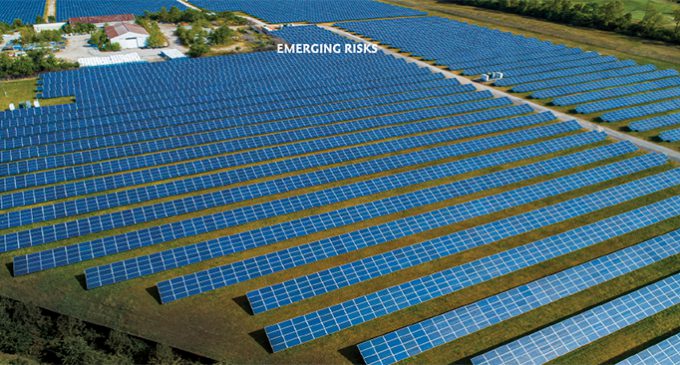Renewable energy risks

The expanding world of
renewable energy risks
A role for agents and brokers
in a burgeoning business
By Maura C. Ciccarelli
With solar, wind, and other renewable energy technologies heating up in popularity, so to speak, agents should be watching for opportunities to enter this expanding market, advises energy broker Clay Fuchs.
The United States is well positioned to provide the resources and support for renewable energy technologies, says Fuchs, area assistant vice president with the energy practice at Risk Placement Services (RPS), an E&S wholesale insurance broker and MGA, based in Rolling Meadows, Illinois.
The United States has many of the raw materials for making equipment, such as solar panels, wind turbines, batteries and more. Sophisticated transportation avenues with rail, freight, and navigable waterways make it easier to spread the renewables around the country. Plus, recent legislation offers economic incentives to expanding the industry and tackling climate change challenges today and in the coming years.
Whether developing renewable energy expertise on their own or working with a broker like RPS, agents have opportunities to enter this growing market, Fuchs says.
Renewable energy, old and new
Fuchs defines renewable energy as tapping into unlimited energy sources like the sun, wind, water, and geothermal, rather than finite sources such as hydrocarbon-based fuels like coal, natural gas, oil, etc., which will eventually run out.
“The original renewable energy was about harnessing the power of rivers to run mills,” he observes. “Today, we use water-powered turbines to create electrical power.”
Fuchs notes several good reasons for why solar and wind are the most popular renewable energy sources. When evaluating projects on a more short-term basis, they can be the most cost effective in terms of output vs. cost input. They can be created and scaled quickly in many different areas. Plus, when located in sun- or wind-rich regions, they produce predictable, consistent energy output.
Renewable energy organizations needing insurance range from startups to established corporations and include inventors, engineering firms, manufacturers, contractors, recyclers, and others involved in the cradle-to-grave process of the industry.

“Keep your head on a swivel if you’re an agent driving around town or in the country. … The risks still aren’t fully known and the size of this [market] still isn’t known.”
—Clay Fuchs
Assistant Vice President, Energy Practice
Risk Placement Services
Emerging risks
While risks in renewables exist, solar and wind can be less risky in the aggregate compared to traditional oil and gas.
One growing component of the renewables industry is battery technology. Capturing and storing energy created by renewable technologies could create more risk in the future, he notes.
“One of the major issues we are going to have to monitor are batteries,” Fuchs says.
“In this growing space, these risks are going to get closer to your front door,” he adds. “For example, we could start to see installation of battery storage facilities for neighborhoods, hospitals, and high energy-use areas. Where traditionally a business or community relied on a generator, they could shift to installing an energy storage supply.”
However, when those battery facilities catch on fire, many dangerous chemicals can escape into the air. “That is a concern we have to watch out for,” he says.
Hydrogen fuel, which once held such promise, has more risk issues than other renewables, so interest in it has been reduced.
“Hydrogen is more hazardous than other renewable energy sources due to the possibilities of explosions,” he says, noting that there’s also insufficient infrastructure for moving and storing the gas. This may limit it to being a smaller, more localized energy resource. “The Inflation Reduction Act provides incentives around using hydrogen as a fuel source and this will be an interesting industry to follow.”
Another upcoming issue will revolve around the materials needed to create renewable energy systems.
“We have to figure out a way to use what we already have and, as we mine new materials, be able to recycle those in a strategic manner,” Fuchs notes.
He adds, “I think eventually we’re going to see everything scaling up across all 50 states. The wind’s always going to be blowing and the sun’s always going to be shining for the most part across some part of the U.S.”
What’s driving renewable energy’s growth?
A big driver behind this trend is the Inflation Reduction Act of 2022. The energy security and climate change section provides industry incentives, particularly for manufacturing renew-able energy products in the United States.
“Renewables are expensive right now because of the costs associated with shipping [components] such as turbines from Europe to the U.S. I think we could see manufacturing facilities pop up where there are large concentrations of wind or solar, lowering shipping costs and getting equipment into the field quicker,” he says.
The current supply-chain crunch will continue to increase costs that make some projects less viable until U.S.-based manufacturing ramps up. Still, Fuchs expects more businesses will be getting into the space in the short term.
“We should continue to see investment in the manufacturing of materials going into renewables,” he says. “There are many widgets that go into the renew-able process. With government funding and investment, we’ll start to see more facilities popping up in the U.S. to create them.”
Contractors that specialize in renewables will also benefit from increased action in this field. For example, wind turbines have a 10- to 20-year shelf life and, as a result, they will need to be taken down and replaced, often with larger and more efficient turbines.
A world of opportunity
“The best part about the renew-able space that I definitely want our agents to be thinking about is the fact that the world’s kind of your oyster here,” he says.
For example, last year he wrote coverage for a startup that’s researching how to improve output of storage batteries. Another risk was a new wind turbine recycling facility in Wyoming.
“Keep your head on a swivel if you’re an agent driving around town or in the country,” he says. “This is still a new world for us and there’s a lot of changes that are going to be coming. The risks still aren’t fully known and the size of this [market] still isn’t known.”
Fuchs also predicts change when it comes to sourcing. “As we start to re-shore manufacturing and the mining of materials, I believe renewables will become more localized,” he explains.
As a result of all these factors, Fuchs says he’s more bullish than ever about the potential of the U.S. renewable energy space and the role insurance agents and brokers can play in supporting this burgeoning industry.
The author
Maura Ciccarelli is a freelance journalist originally from Philadelphia who now writes about business and more from the road full-time.











